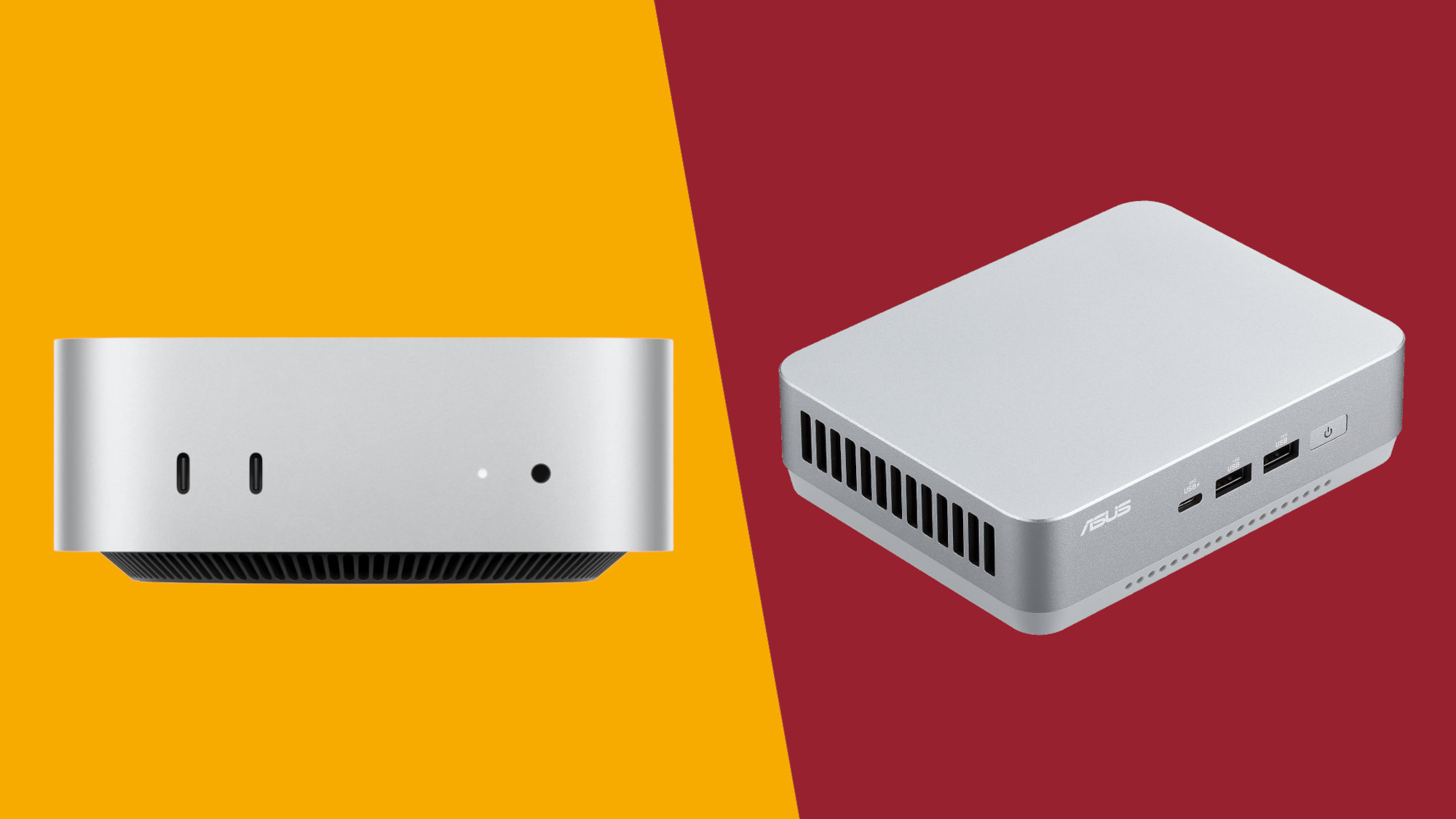
The new Mac mini launched in November 2024, delivering us a tiny Mac equipped with the newly powered-up M4 chip. With a physical redesign making the M4 model even smaller than previous models, the latest Mac mini is a miniature workstation system, even capable of handling some gaming. In our review, we gave it a rare five-star rating.
The NUC range is Intel's mini-PC brand, though Intel only makes the internal components these days; the PCs themselves are designed and sold by third-party manufacturers such as Asus (who made the NUC 14 Pro+ pictured above). NUCs are great as compact work PCs and home entertainment systems, bringing a fully-fledged Windows desktop experience in a tiny form factor.
If you’re buying a mini PC (and you want something that’s capable of doing more than just answering emails), you’ve got two main options: Apple’s Mac mini, recently turbocharged with the M4 chip, or one of the many Intel NUC configurations out there, such as the Asus NUC 14 Pro+.
I’m not going to beat around the bush here: never have I written such a decisive versus article for TechRadar or anywhere else. The Mac mini stomps the tiny computer competition; the only reason to buy a NUC or a similar AMD-powered compact PC is if you hate macOS so much that you’ve somehow developed an actual allergy to it.
Still, I’ve been a journalist long enough to know that you have to back up statements like that with facts and logic – so let’s get straight down to business, starting with price.
Apple Mac mini Vs Intel NUC: Price

I’m going to be focusing mainly on the 2024 M4 Mac mini here, which starts at $599 / £599 / AU$999 - the same base pricing as its M2 predecessor. It was nice to not see a generational price jump (something Apple is frequently guilty of), as the Mac mini has consistently offered some of the best value for money in compact computing since the introduction of Apple’s in-house M-series silicon.
Meanwhile, NUC pricing varies wildly; online stores are filled with outdated models, but pricing on mainstream current-gen iterations from the likes of Asus sit in the $600-900 range in the US, £600-900 in the UK, and anything from AU$1,500 and up in Australia (seriously, the AU pricing is pretty terrible for most NUCs).
At first glance, the Mac mini wins comfortably here – especially since users on a budget can pick up an M2 model for below the original asking price these days – but Apple users will need to fork over some extra cash if they want to upgrade from the base Mac mini’s 16GB of RAM and 256GB SSD. However, every current-gen NUC that even approaches the Mac mini’s price is a ‘barebones’ unit that doesn’t come with RAM or an SSD, meaning you'll need to purchase them separately. So even at second, third, and fourth glance, the Mac mini still wins.
- Winner: Mac mini
Apple Mac mini Vs Intel NUC: Design

This is a trickier one to gauge, since the M4 Mac mini has a singular uniform design, updated from the M2 model to make it even more breathtakingly tiny, while NUCs come in all shapes (though mostly the same compact size) since they’re made by third-party manufacturers using Intel’s Core chips.
As a result, personal preference will come into play here: the new Mac mini design is excellent, and it certainly looks nicer than any NUC I’ve ever seen, but there are a few pain points to note; the power button being on the underside of the device was a bit of an odd choice by Apple (though it’s far from their most egregious design decision), and the total lack of USB-A ports will disappoint some users.
The variety of NUCs available means you’ll likely be able to find one that perfectly suits your needs in terms of design practicality, but the M4 Mac mini does have a slightly smaller footprint than all but the most svelte NUC models in addition to having a stylish appearance and highly effective cooling despite its ultra-compact design.
- Winner: Tie
Apple Mac mini Vs Intel NUC: Performance

Yeah, you guessed it: the M4 Mac mini once again dominates in this area, delivering shockingly great performance for such a small and affordable device.
Now, granted, you could feasibly configure a NUC with an Intel Core Ultra 9 chip and a ridiculous 96GB+ of RAM, but that’s going to cost you a fair bit of cash, and will only give diminishing returns as you pour more money into your tiny PC.
The fact is that the M4 chip – combined with Apple’s carefully controlled mainboard specs and software ecosystem – simply offers more firepower than current-gen Intel Core Ultra CPUs: faster individual CPU cores, a better integrated GPU, and a Neural Engine for AI workloads that offers 38 trillion operations per second versus the Intel Core Ultra 9 185H’s 34. Even with Intel’s Core Ultra 200 chips landing (sure to crop up in new NUCs soon) and bringing better NPU performance to the table, it’s really no contest. Sorry, Intel. Again.
- Winner: Mac mini
Apple Mac mini Vs Intel NUC: Verdict
It might be shocking to some of my long-time friends and readers (and, y’know, Apple itself) that I’m saying this, but the M4 Mac mini is the indisputable winner here.
Yes, my dislike of Apple hardware is long-standing and well-documented, but I’m no fool: the new Mac mini is possibly the best Mac device Apple has ever made, and it definitely provides the most bang for your buck out of any macOS device. I don’t even say this as someone who doesn’t like NUCs – I’ve long been a fan of tiny PCs, and the new Intel Core Ultra chips are reasonably good, but pitting them against Apple’s latest and greatest simply isn’t a fair fight.
In retrospect, I’m not even sure why I wrote this article. After all, the Mac mini already occupies the number one spot in our best mini PCs guide. But the sunk cost fallacy dictates that I should wrap it up and publish it, so thanks for reading this far – now go buy yourself a Mac mini, and learn to love it as I have.
- Winner: Mac mini







